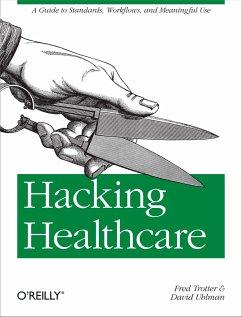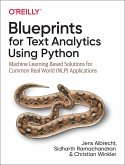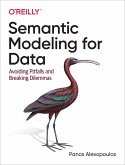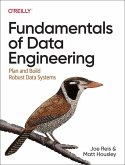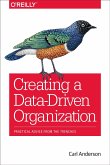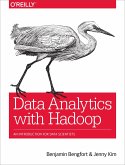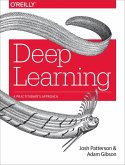19,99 €
inkl. MwSt.
Versandfertig in 2-4 Wochen

10 °P sammeln
- Broschiertes Buch
- Merkliste
- Auf die Merkliste
- Bewerten Bewerten
- Teilen
- Produkt teilen
- Produkterinnerung
- Produkterinnerung
Ready to take your IT skills to the healthcare industry? This concise book provides a candid assessment of the US healthcare system as it ramps up its use of electronic health records (EHRs) and other forms of IT to comply with the government’s Meaningful Use requirements. It’s a tremendous opportunity for tens of thousands of IT professionals, but it’s also a huge challenge: the program requires a complete makeover of archaic records systems, workflows, and other practices now in place. This book points out how hospitals and doctors’ offices differ from other organizations that use IT, and…mehr
Andere Kunden interessierten sich auch für
![Blueprints for Text Analytics Using Python Blueprints for Text Analytics Using Python]() Jens AlbrechtBlueprints for Text Analytics Using Python67,99 €
Jens AlbrechtBlueprints for Text Analytics Using Python67,99 €![Semantic Modeling for Data Semantic Modeling for Data]() Panos AlexopoulosSemantic Modeling for Data75,99 €
Panos AlexopoulosSemantic Modeling for Data75,99 €![Fundamentals of Data Engineering Fundamentals of Data Engineering]() Joe ReisFundamentals of Data Engineering67,99 €
Joe ReisFundamentals of Data Engineering67,99 €![Creating a Data-Driven Organization Creating a Data-Driven Organization]() Carl AndersonCreating a Data-Driven Organization39,99 €
Carl AndersonCreating a Data-Driven Organization39,99 €![Data Analytics with Hadoop Data Analytics with Hadoop]() Benjamin BengfortData Analytics with Hadoop31,99 €
Benjamin BengfortData Analytics with Hadoop31,99 €![Why Data Science Projects Fail Why Data Science Projects Fail]() Douglas GrayWhy Data Science Projects Fail34,99 €
Douglas GrayWhy Data Science Projects Fail34,99 €![Deep Learning Deep Learning]() Josh PattersonDeep Learning52,99 €
Josh PattersonDeep Learning52,99 €-
-
-
Ready to take your IT skills to the healthcare industry? This concise book provides a candid assessment of the US healthcare system as it ramps up its use of electronic health records (EHRs) and other forms of IT to comply with the government’s Meaningful Use requirements. It’s a tremendous opportunity for tens of thousands of IT professionals, but it’s also a huge challenge: the program requires a complete makeover of archaic records systems, workflows, and other practices now in place. This book points out how hospitals and doctors’ offices differ from other organizations that use IT, and explains what’s necessary to bridge the gap between clinicians and IT staff. * Get an overview of EHRs and the differences among medical settings * Learn the variety of ways institutions deal with patients and medical staff, and how workflows vary * Discover healthcare’s dependence on paper records, and the problems involved in migrating them to digital documents * Understand how providers charge for care, and how they get paid * Explore how patients can use EHRs to participate in their own care * Examine healthcare’s most pressing problem—avoidable errors—and how EHRs can both help and exacerbate it
Hinweis: Dieser Artikel kann nur an eine deutsche Lieferadresse ausgeliefert werden.
Hinweis: Dieser Artikel kann nur an eine deutsche Lieferadresse ausgeliefert werden.
Produktdetails
- Produktdetails
- Real Time Bks.
- Verlag: O'Reilly Media
- Seitenzahl: 245
- Erscheinungstermin: 22. November 2011
- Englisch
- Abmessung: 233mm x 179mm x 20mm
- Gewicht: 444g
- ISBN-13: 9781449305024
- ISBN-10: 1449305024
- Artikelnr.: 33651811
- Herstellerkennzeichnung
- Libri GmbH
- Europaallee 1
- 36244 Bad Hersfeld
- gpsr@libri.de
- Real Time Bks.
- Verlag: O'Reilly Media
- Seitenzahl: 245
- Erscheinungstermin: 22. November 2011
- Englisch
- Abmessung: 233mm x 179mm x 20mm
- Gewicht: 444g
- ISBN-13: 9781449305024
- ISBN-10: 1449305024
- Artikelnr.: 33651811
- Herstellerkennzeichnung
- Libri GmbH
- Europaallee 1
- 36244 Bad Hersfeld
- gpsr@libri.de
Fred Trotter is a hacktivist. He works for social change by coding and promoting Open Source Health Software. In recognition of his role within the Open Source Health Informatics community, Trotter was the only Open Source representative invited by congress to testify on the definition of 'meaningful use' for the federal health care incentives law (Meaningful Use). Trotter also represented the Open Source EHR community in negotiations with CCHIT, the leading EHR certification body. Trotter is the original author of FreeB, the worlds first GPL medical billing engine. In 2004 Fred Trotter received the LinuxMedNews achievement award for work on FreeB. Fred Trotter was an editor for the Open Source EHR review project with the American Medical Informatics Association (AMIA), Open Source Working Group (oswg). Fred is a member of WorldVistA and is the programmer behind Astronaut Shuttle which is the first cloud-based VA VistA offering. Fred Trotter is a recognized expert in Free and Open Source medical software and security systems. He has spoken on those subjects at the SCALE DOHCS conference, OSCON, LinuxWorld, DefCon and is the MC for the Open Source Health Conference. He has been quoted in multiple articles on Health Information Technology in several print and online journals, including WIRED, ZSnet, Government Health IT, Modern Healthcare, Linux Journal, Free Software Magazine, NPR and LinuxMedNews. Trotter has a B.S in Computer Science, a B.A in psychology and a B.A in philosophy from Trinity University. Trotter minored in Business Administration, Cognitive Science, and Management Information Systems. Before working directly on health software, Trotter passed the CISSP certification and consulted for VeriSign on HIPAA security for major hospitals and health institutions. Trotter was originally trained on information security at the Air Force Information Warfare Center. David is CEO of ClearHealth Inc. which created and supports ClearHealth, the first and only open source Meaningful Use certified Comprehensive Ambulatory EHR. Coming from a background of supply chain systems and big business ERP for companies including DEC, Micro Systems, Motorola, and EDS, David entered health care in 2001 as CTO for the OpenEHR project. One of the first companies to try commercializing open source healthcare systems, OpenEHR met face first with thedifficult realities of bringing proven mainstream technologies into the complicated and sometimes nonsensical world of health care. In 2003 David became CEO of ClearHealth and created theClearHealth system based on VistA that was originally developed by the Veterans Health Administration. ClearHealth's software is open source (GPL) and powers more than 1,000 sites from small offices to mega-institutions servicing millions of patients per year. As CEO of ClearHealth Inc. David alsooversees outsourced management and operations consulting of several general practice groups and in 2013 will begin operating it's own general practice facilities. A frequent speaker and writer David has presented and OSCON, TEPR, LinuxWorld, SCALE, OSHC, and others. You can see his work online in Modern Health Care, Wired, Linux Journal, and on his blog: Health 365.
Preface
Audience
Organization
Conventions Used in This Book
Using Code Examples
Safari® Books Online
How to Contact Us
Acknowledgments
Chapter 1: Introduction
1.1 Health IT and Medical Science
1.2 Meaningful Use and What It Means to Be an EHR
1.3 Why So Late?
1.4 Health IT in Health Reform
1.5 Evolution of Meaningful Use
1.6 Accountable Care Organizations
1.7 EHR Functionality in Context
Chapter 2: An Anatomy of Medical Practice
2.1 How Patients Reach Healthcare Organizations
2.2 Lab Sample Collection Before a Visit or Admission Date
2.3 HIPAA and Patient Identification
2.4 Intake, Demographics, Visits, and Admissions
2.5 Precertification and Prior Authorization
2.6 Emergency Admissions
2.7 Prioritization and Triage
2.8 Outpatient Care
2.9 Inpatient Care
2.10 Labs
2.11 Imaging
2.12 Administration and Billing
Chapter 3: Medical Billing
3.1 Who Pays, and How
3.2 Claims
3.3 Eligibility
3.4 Treatment
3.5 Billing
3.6 Adjudication
3.7 The Patient's Burden
Chapter 4: The Bandwidth of Paper
4.1 Workflow Tokens
4.2 Why Leave Paper?
4.3 Step 0: Health IT Humility
4.4 Normalized Data
4.5 Good Boundaries Mean Good Data
4.6 Data at Peace with Itself: Linked Data
4.7 Flexible Data
4.8 Assume Health Data Changes
4.9 Free Text Data
Chapter 5: Herding Cats: Healthcare Management and Business Office Operations
5.1 Major Business Office Activities
5.2 The Evolution of the Business Office
Chapter 6: Patient-Facing Software
6.1 The PHR as Platform
6.2 Sharing Data in Patient-Facing Software
6.3 Patients Using Normal Social Media
6.4 E-patients
6.5 The Quantified Self
6.6 Patient-Focused Social Media
6.7 Patient Privacy in PHR Systems
6.8 Specific PHR and Patient-Directed Meaningful Use Requirements
Chapter 7: Human Error
7.1 The Extent of Error
7.2 Dangerous Dosing
7.3 Discontents of Computerization
7.4 Process Errors and Organizational Change
7.5 Deep Medical Errors and EHR Solutions
7.6 Errors Caused by Human-Computer Mismatch
7.7 Best Practices
Chapter 8: Meaningful Use Overview
8.1 Outpatient Guidelines and Requirements
8.2 Inpatient Guidelines and Requirements
Chapter 9: A Selective History of EHR Technology
9.1 MUMPS: The Programming Language for Healthcare
9.2 Where Can We Buy Some Light Bulbs?
9.3 Fragmentation
9.4 In an Environment with Gag Clauses and No Consumer Reports
9.5 VistA History
Chapter 10: Ontologies
10.1 A Throw-Away Ontology
10.2 Learning from Our Example
10.3 CPT Codes, Sermo, and CMS
10.4 International Classification of Diseases (ICD)
10.5 E-patient-Dave-gate
10.6 Crosswalks and ICD Versions
10.7 Other Claims Codes
10.8 Drug Databases
10.9 SNOMED to the Rescue
10.10 UMLS: The Universal Mapping Metaontology
10.11 Extending Ontologies
10.12 Other Ontologies
10.13 Sneaky Ontologies
10.14 Ontologies Using APIs
10.15 Exercising Ontologies
Chapter 11: Interoperability
11.1 Some Lessons from Earlier Exchanges
11.2 The New HIE Rules
11.3 Strong Standards
11.4 Winning Protocols
11.5 The Billing Protocols
11.6 HL7 Version 2
11.7 First-Generation and Second-Generation HIEs
11.8 Continuity of Care Record
11.9 HL7 v3, RIM, CDA, CDD, and HITSP C32
11.10 The IHE Protocol
11.11 HIE with IHE
11.12 The Direct Project/Protocol
11.13 The PCAST Report
11.14 The SMART Platform
11.15 Technology and Policy Were Sitting in the Tree
Chapter 12: HIPAA: The Far-Reaching Healthcare Regulation
12.1 Does HIPAA Cover Me?
12.2 Responsibilities of Covered Entities
12.3 HIPAA: A Reasonable Regulation
12.4 Duct-Tape HIPAA Strategies
12.5 Breach Notification Rules
12.6 In Summary
Chapter 13: Open Source Systems
13.1 Why Open Source?
13.2 Major Open Source Healthcare Projects
13.3 VistA Variants and Other Certified Open Source EHR Systems
13.4 OpenMRS
Meaningful Use Implementation Assessment
Audience
Organization
Conventions Used in This Book
Using Code Examples
Safari® Books Online
How to Contact Us
Acknowledgments
Chapter 1: Introduction
1.1 Health IT and Medical Science
1.2 Meaningful Use and What It Means to Be an EHR
1.3 Why So Late?
1.4 Health IT in Health Reform
1.5 Evolution of Meaningful Use
1.6 Accountable Care Organizations
1.7 EHR Functionality in Context
Chapter 2: An Anatomy of Medical Practice
2.1 How Patients Reach Healthcare Organizations
2.2 Lab Sample Collection Before a Visit or Admission Date
2.3 HIPAA and Patient Identification
2.4 Intake, Demographics, Visits, and Admissions
2.5 Precertification and Prior Authorization
2.6 Emergency Admissions
2.7 Prioritization and Triage
2.8 Outpatient Care
2.9 Inpatient Care
2.10 Labs
2.11 Imaging
2.12 Administration and Billing
Chapter 3: Medical Billing
3.1 Who Pays, and How
3.2 Claims
3.3 Eligibility
3.4 Treatment
3.5 Billing
3.6 Adjudication
3.7 The Patient's Burden
Chapter 4: The Bandwidth of Paper
4.1 Workflow Tokens
4.2 Why Leave Paper?
4.3 Step 0: Health IT Humility
4.4 Normalized Data
4.5 Good Boundaries Mean Good Data
4.6 Data at Peace with Itself: Linked Data
4.7 Flexible Data
4.8 Assume Health Data Changes
4.9 Free Text Data
Chapter 5: Herding Cats: Healthcare Management and Business Office Operations
5.1 Major Business Office Activities
5.2 The Evolution of the Business Office
Chapter 6: Patient-Facing Software
6.1 The PHR as Platform
6.2 Sharing Data in Patient-Facing Software
6.3 Patients Using Normal Social Media
6.4 E-patients
6.5 The Quantified Self
6.6 Patient-Focused Social Media
6.7 Patient Privacy in PHR Systems
6.8 Specific PHR and Patient-Directed Meaningful Use Requirements
Chapter 7: Human Error
7.1 The Extent of Error
7.2 Dangerous Dosing
7.3 Discontents of Computerization
7.4 Process Errors and Organizational Change
7.5 Deep Medical Errors and EHR Solutions
7.6 Errors Caused by Human-Computer Mismatch
7.7 Best Practices
Chapter 8: Meaningful Use Overview
8.1 Outpatient Guidelines and Requirements
8.2 Inpatient Guidelines and Requirements
Chapter 9: A Selective History of EHR Technology
9.1 MUMPS: The Programming Language for Healthcare
9.2 Where Can We Buy Some Light Bulbs?
9.3 Fragmentation
9.4 In an Environment with Gag Clauses and No Consumer Reports
9.5 VistA History
Chapter 10: Ontologies
10.1 A Throw-Away Ontology
10.2 Learning from Our Example
10.3 CPT Codes, Sermo, and CMS
10.4 International Classification of Diseases (ICD)
10.5 E-patient-Dave-gate
10.6 Crosswalks and ICD Versions
10.7 Other Claims Codes
10.8 Drug Databases
10.9 SNOMED to the Rescue
10.10 UMLS: The Universal Mapping Metaontology
10.11 Extending Ontologies
10.12 Other Ontologies
10.13 Sneaky Ontologies
10.14 Ontologies Using APIs
10.15 Exercising Ontologies
Chapter 11: Interoperability
11.1 Some Lessons from Earlier Exchanges
11.2 The New HIE Rules
11.3 Strong Standards
11.4 Winning Protocols
11.5 The Billing Protocols
11.6 HL7 Version 2
11.7 First-Generation and Second-Generation HIEs
11.8 Continuity of Care Record
11.9 HL7 v3, RIM, CDA, CDD, and HITSP C32
11.10 The IHE Protocol
11.11 HIE with IHE
11.12 The Direct Project/Protocol
11.13 The PCAST Report
11.14 The SMART Platform
11.15 Technology and Policy Were Sitting in the Tree
Chapter 12: HIPAA: The Far-Reaching Healthcare Regulation
12.1 Does HIPAA Cover Me?
12.2 Responsibilities of Covered Entities
12.3 HIPAA: A Reasonable Regulation
12.4 Duct-Tape HIPAA Strategies
12.5 Breach Notification Rules
12.6 In Summary
Chapter 13: Open Source Systems
13.1 Why Open Source?
13.2 Major Open Source Healthcare Projects
13.3 VistA Variants and Other Certified Open Source EHR Systems
13.4 OpenMRS
Meaningful Use Implementation Assessment
Preface
Audience
Organization
Conventions Used in This Book
Using Code Examples
Safari® Books Online
How to Contact Us
Acknowledgments
Chapter 1: Introduction
1.1 Health IT and Medical Science
1.2 Meaningful Use and What It Means to Be an EHR
1.3 Why So Late?
1.4 Health IT in Health Reform
1.5 Evolution of Meaningful Use
1.6 Accountable Care Organizations
1.7 EHR Functionality in Context
Chapter 2: An Anatomy of Medical Practice
2.1 How Patients Reach Healthcare Organizations
2.2 Lab Sample Collection Before a Visit or Admission Date
2.3 HIPAA and Patient Identification
2.4 Intake, Demographics, Visits, and Admissions
2.5 Precertification and Prior Authorization
2.6 Emergency Admissions
2.7 Prioritization and Triage
2.8 Outpatient Care
2.9 Inpatient Care
2.10 Labs
2.11 Imaging
2.12 Administration and Billing
Chapter 3: Medical Billing
3.1 Who Pays, and How
3.2 Claims
3.3 Eligibility
3.4 Treatment
3.5 Billing
3.6 Adjudication
3.7 The Patient's Burden
Chapter 4: The Bandwidth of Paper
4.1 Workflow Tokens
4.2 Why Leave Paper?
4.3 Step 0: Health IT Humility
4.4 Normalized Data
4.5 Good Boundaries Mean Good Data
4.6 Data at Peace with Itself: Linked Data
4.7 Flexible Data
4.8 Assume Health Data Changes
4.9 Free Text Data
Chapter 5: Herding Cats: Healthcare Management and Business Office Operations
5.1 Major Business Office Activities
5.2 The Evolution of the Business Office
Chapter 6: Patient-Facing Software
6.1 The PHR as Platform
6.2 Sharing Data in Patient-Facing Software
6.3 Patients Using Normal Social Media
6.4 E-patients
6.5 The Quantified Self
6.6 Patient-Focused Social Media
6.7 Patient Privacy in PHR Systems
6.8 Specific PHR and Patient-Directed Meaningful Use Requirements
Chapter 7: Human Error
7.1 The Extent of Error
7.2 Dangerous Dosing
7.3 Discontents of Computerization
7.4 Process Errors and Organizational Change
7.5 Deep Medical Errors and EHR Solutions
7.6 Errors Caused by Human-Computer Mismatch
7.7 Best Practices
Chapter 8: Meaningful Use Overview
8.1 Outpatient Guidelines and Requirements
8.2 Inpatient Guidelines and Requirements
Chapter 9: A Selective History of EHR Technology
9.1 MUMPS: The Programming Language for Healthcare
9.2 Where Can We Buy Some Light Bulbs?
9.3 Fragmentation
9.4 In an Environment with Gag Clauses and No Consumer Reports
9.5 VistA History
Chapter 10: Ontologies
10.1 A Throw-Away Ontology
10.2 Learning from Our Example
10.3 CPT Codes, Sermo, and CMS
10.4 International Classification of Diseases (ICD)
10.5 E-patient-Dave-gate
10.6 Crosswalks and ICD Versions
10.7 Other Claims Codes
10.8 Drug Databases
10.9 SNOMED to the Rescue
10.10 UMLS: The Universal Mapping Metaontology
10.11 Extending Ontologies
10.12 Other Ontologies
10.13 Sneaky Ontologies
10.14 Ontologies Using APIs
10.15 Exercising Ontologies
Chapter 11: Interoperability
11.1 Some Lessons from Earlier Exchanges
11.2 The New HIE Rules
11.3 Strong Standards
11.4 Winning Protocols
11.5 The Billing Protocols
11.6 HL7 Version 2
11.7 First-Generation and Second-Generation HIEs
11.8 Continuity of Care Record
11.9 HL7 v3, RIM, CDA, CDD, and HITSP C32
11.10 The IHE Protocol
11.11 HIE with IHE
11.12 The Direct Project/Protocol
11.13 The PCAST Report
11.14 The SMART Platform
11.15 Technology and Policy Were Sitting in the Tree
Chapter 12: HIPAA: The Far-Reaching Healthcare Regulation
12.1 Does HIPAA Cover Me?
12.2 Responsibilities of Covered Entities
12.3 HIPAA: A Reasonable Regulation
12.4 Duct-Tape HIPAA Strategies
12.5 Breach Notification Rules
12.6 In Summary
Chapter 13: Open Source Systems
13.1 Why Open Source?
13.2 Major Open Source Healthcare Projects
13.3 VistA Variants and Other Certified Open Source EHR Systems
13.4 OpenMRS
Meaningful Use Implementation Assessment
Audience
Organization
Conventions Used in This Book
Using Code Examples
Safari® Books Online
How to Contact Us
Acknowledgments
Chapter 1: Introduction
1.1 Health IT and Medical Science
1.2 Meaningful Use and What It Means to Be an EHR
1.3 Why So Late?
1.4 Health IT in Health Reform
1.5 Evolution of Meaningful Use
1.6 Accountable Care Organizations
1.7 EHR Functionality in Context
Chapter 2: An Anatomy of Medical Practice
2.1 How Patients Reach Healthcare Organizations
2.2 Lab Sample Collection Before a Visit or Admission Date
2.3 HIPAA and Patient Identification
2.4 Intake, Demographics, Visits, and Admissions
2.5 Precertification and Prior Authorization
2.6 Emergency Admissions
2.7 Prioritization and Triage
2.8 Outpatient Care
2.9 Inpatient Care
2.10 Labs
2.11 Imaging
2.12 Administration and Billing
Chapter 3: Medical Billing
3.1 Who Pays, and How
3.2 Claims
3.3 Eligibility
3.4 Treatment
3.5 Billing
3.6 Adjudication
3.7 The Patient's Burden
Chapter 4: The Bandwidth of Paper
4.1 Workflow Tokens
4.2 Why Leave Paper?
4.3 Step 0: Health IT Humility
4.4 Normalized Data
4.5 Good Boundaries Mean Good Data
4.6 Data at Peace with Itself: Linked Data
4.7 Flexible Data
4.8 Assume Health Data Changes
4.9 Free Text Data
Chapter 5: Herding Cats: Healthcare Management and Business Office Operations
5.1 Major Business Office Activities
5.2 The Evolution of the Business Office
Chapter 6: Patient-Facing Software
6.1 The PHR as Platform
6.2 Sharing Data in Patient-Facing Software
6.3 Patients Using Normal Social Media
6.4 E-patients
6.5 The Quantified Self
6.6 Patient-Focused Social Media
6.7 Patient Privacy in PHR Systems
6.8 Specific PHR and Patient-Directed Meaningful Use Requirements
Chapter 7: Human Error
7.1 The Extent of Error
7.2 Dangerous Dosing
7.3 Discontents of Computerization
7.4 Process Errors and Organizational Change
7.5 Deep Medical Errors and EHR Solutions
7.6 Errors Caused by Human-Computer Mismatch
7.7 Best Practices
Chapter 8: Meaningful Use Overview
8.1 Outpatient Guidelines and Requirements
8.2 Inpatient Guidelines and Requirements
Chapter 9: A Selective History of EHR Technology
9.1 MUMPS: The Programming Language for Healthcare
9.2 Where Can We Buy Some Light Bulbs?
9.3 Fragmentation
9.4 In an Environment with Gag Clauses and No Consumer Reports
9.5 VistA History
Chapter 10: Ontologies
10.1 A Throw-Away Ontology
10.2 Learning from Our Example
10.3 CPT Codes, Sermo, and CMS
10.4 International Classification of Diseases (ICD)
10.5 E-patient-Dave-gate
10.6 Crosswalks and ICD Versions
10.7 Other Claims Codes
10.8 Drug Databases
10.9 SNOMED to the Rescue
10.10 UMLS: The Universal Mapping Metaontology
10.11 Extending Ontologies
10.12 Other Ontologies
10.13 Sneaky Ontologies
10.14 Ontologies Using APIs
10.15 Exercising Ontologies
Chapter 11: Interoperability
11.1 Some Lessons from Earlier Exchanges
11.2 The New HIE Rules
11.3 Strong Standards
11.4 Winning Protocols
11.5 The Billing Protocols
11.6 HL7 Version 2
11.7 First-Generation and Second-Generation HIEs
11.8 Continuity of Care Record
11.9 HL7 v3, RIM, CDA, CDD, and HITSP C32
11.10 The IHE Protocol
11.11 HIE with IHE
11.12 The Direct Project/Protocol
11.13 The PCAST Report
11.14 The SMART Platform
11.15 Technology and Policy Were Sitting in the Tree
Chapter 12: HIPAA: The Far-Reaching Healthcare Regulation
12.1 Does HIPAA Cover Me?
12.2 Responsibilities of Covered Entities
12.3 HIPAA: A Reasonable Regulation
12.4 Duct-Tape HIPAA Strategies
12.5 Breach Notification Rules
12.6 In Summary
Chapter 13: Open Source Systems
13.1 Why Open Source?
13.2 Major Open Source Healthcare Projects
13.3 VistA Variants and Other Certified Open Source EHR Systems
13.4 OpenMRS
Meaningful Use Implementation Assessment
